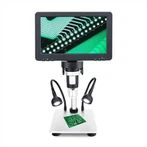Key factors for the correct measurement of infrared temperature
To ensure correct non-contact infrared temperature measurements
-Distance ratio to the target (point of light)
-Field of view
-Ambient conditions
-Ambient temperature
-Emission rate
Distance ratio to target (point of light)
The optical system of an infrared sensor collects the energy from a circular measuring point and converges it at the detector. The optical resolution is determined by the ratio of the distance from the device to the object to the size of the measured point of light (D:S ratio). The larger the ratio, the better the resolution of the device, allowing smaller points of light to be measured from greater distances. The latest in infrared optics is the addition of near-focus characteristics that provide accurate measurements of small target areas without undesired background temperatures.
Laser infrared thermometer field of view
Make sure the target is larger than the spot size the device is measuring. The smaller the target, the closer you should be. When accuracy is particularly important, make sure the target is at least twice the spot size.
Laser infrared thermometer environmental conditions
Pay attention to the environmental conditions in your work area. Steam, dust, smoke, etc. can block the device's lens, which can hinder measurements. Other conditions such as noise, electromagnetic fields, or vibration should also be considered before installation begins. Protective enclosures, air purging, and air or water cooling protect the sensor and ensure accurate measurements.
Ambient temperature (surrounding temperature)
If the pyrometer is exposed to an unexpected temperature difference of more than 20°C, keep it there for at least 20 minutes to allow it to acclimatise to the new ambient temperature.JTCIN high-temperature pyrometer stationary sensors are designed to optimise their performance for specific ambient temperature ranges.
Laser infrared thermometer emissivity
Emissivity is a measure of an object's ability to radiate infrared energy. The energy radiated indicates the temperature of the object. Emissivity can take values from 0 (for a polished mirror) to 1.0 (for a blackbody). Learn about emissivity and emissivity values for various materials.






